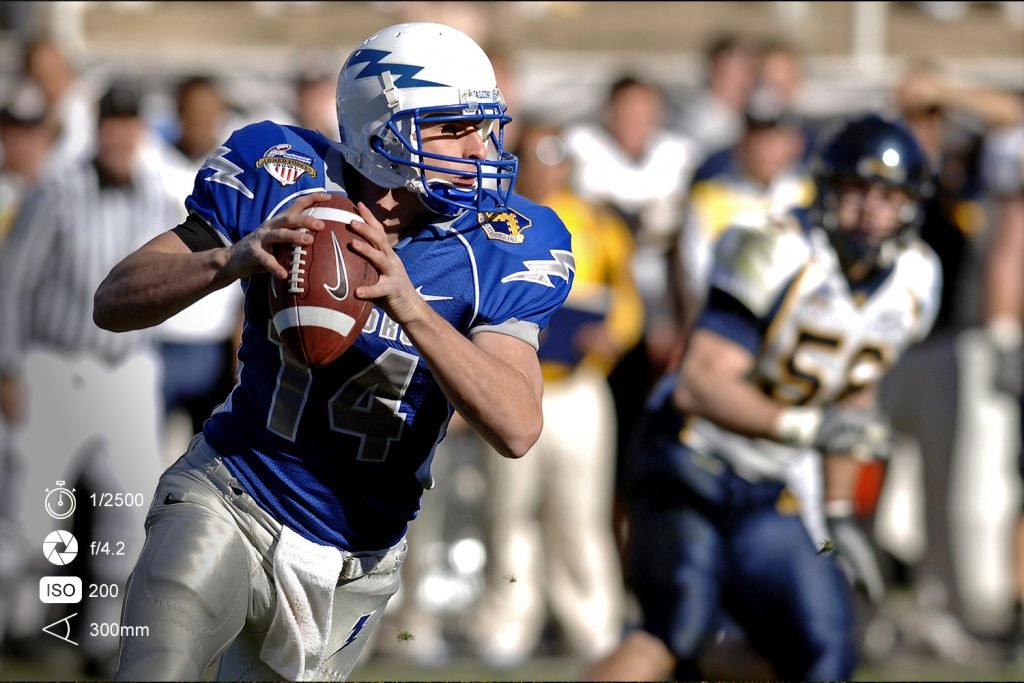Last updated on December 7th, 2023
You want to take great football photos but do not know where to start.
Even if you have a basic understanding of photography, taking good football photos can take time and effort. There are many things to consider- subject distance, shutter speed, lighting, etc.

This beginner’s guide to football photography will walk you through all the basics you need to know to take fantastic football photos. You’ll learn about camera settings, lens choice, and how to capture the perfect moment on game day.
Sports photography is a challenging and rewarding endeavor. With the proper knowledge and practice, you can take stunning photos capturing the game’s excitement and energy. So let’s get started!

What Equipment Do You Need for Football Photography
A Good Camera
Of course, the essential piece of equipment for football photography is a good camera. A DSLR camera with a fast shutter speed and a long zoom lens will allow you to capture great action shots of the game. If you don’t have a DSLR camera, a point-and-shoot camera with a good zoom lens can also work well.
A Tripod
Another vital piece of equipment for football photography is a tripod. A tripod will help to keep your camera steady when taking photos, which is especially important when using a long zoom lens. Additionally, a tripod can be handy when taking photos in low-light conditions.
A Telephoto Lens
A telephoto lens is another essential piece of equipment for football photography. A telephoto lens will allow you to zoom in on the action and capture close-up shots of the players and the game.
A Wide-Angle Lens
A wide-angle lens can also be helpful for football photography. A wide-angle lens will allow you to capture wide shots of the field, which can be helpful when trying to capture the game’s overall feel.
A Flash (optional)
A flash can also be helpful for football photography, especially when shooting in low-light conditions. A flash will help illuminate the subjects in your photos and freeze the action, which can be helpful when trying to capture fast-paced plays.

What Camera Settings Should You Use?
Aperture
Aperture is one of the three main camera settings you must be aware of when shooting football. Aperture refers to the size of the opening in the lens through which light passes. The larger the aperture, you will let in more light, and vice versa. A larger aperture will also result in a shallower field depth, meaning that only a tiny portion of the image will be in focus. This can be useful for isolating your subject from the background.
Shutter Speed
Shutter speed is another vital camera setting to consider when shooting football. Shutter speed refers to the time the shutter is open, and you measure it in fractions of a second. A faster shutter speed will result in less light being let in, but it will also freeze motion, which can be helpful for action shots. A slower shutter speed will let in more light. It will also allow you to capture movement, which can help create a sense of dynamism in your images.
ISO
ISO is the third primary camera setting you should know. ISO refers to the sensor’s sensitivity to light and is measured in numbers such as 100, 200, 400, etc. A higher ISO setting will result in more light being let in, but it will also create more noise in your image. Noise is an undesirable effect that appears as speckles or graininess and can reduce the quality of your image.
White Balance
White balance is a setting that you can use to adjust the overall color tone of your image. The white balance setting is usually represented by several Kelvin (K). For example, if you are shooting under fluorescent lighting, you would use a white balance setting of around 4000K. If you are shooting under tungsten lighting, you will use a white balance setting of around 3200K. And if you are shooting under natural sunlight, you would use a white balance setting of around 5500K.
Exposure Compensation
Exposure compensation is a feature you can use to make slight adjustments to the exposure of your image. The exposure depends on your aperture, shutter speed, and ISO settings. Exposure compensation allows you to make your image darker or lighter without changing these settings. This can be useful if you find your images too dark or too light when using automatic mode.
Focus Mode
There are two main focus modes: single point and continuous. Single-point focus allows you to select a specific point on which to focus. In contrast, continuous focus tracks moving subjects and keeps them focused around the frame.
How to Photograph Football Games
Find a good location
When photographing football, the first step is finding a good location. You want to ensure that you have a clear view of the field and that any players or other objects do not obstruct you. You also want to make sure that your location is far enough away from the action so that you can capture it without being too close.
Use a tripod
If you want the best possible results, consider using a tripod or monopod. A tripod will help keep your camera still and allow you to use lower shutter speeds without getting blurry photos.
Select the right settings
As we mentioned, aperture, shutter speed, and ISO are the three main camera settings you need to be aware of. You should select the aperture setting first, as this will determine how much light is let in and how shallow your depth of field will be. If you want to freeze action, you must use a fast shutter speed. And if you want to reduce noise in your image, you should use a lower ISO setting.
Compose your shot
It would help if you tried to fill the frame with as much action as possible when composing your shot. This can be challenging, as football players constantly move around the field. One way to overcome this is to focus on a specific player and follow them with your camera. Another way is to zoom in so that only a tiny portion of the field is visible in the frame.
Take lots of photos
Football is fast-paced, so you will need to take a lot of photos to get some good shots. The best way to do this is to set your camera to continuous shooting mode. This will allow you to take multiple photos quickly and increase your chances of getting a great shot.
Edit your photos
After you have taken your photos, you should take some time to edit them. This can be done using a simple photo editing program like Photoshop or Lightroom. Editing your photos will allow you to adjust the exposure, white balance, and other settings. It will also allow you to crop photos and remove unwanted objects from the frame.

Tips for Taking Excellent Football Photos
Use a telephoto lens
A telephoto lens is a type of camera lens that allows you to take photos from a distance. This is important for football photography because it allows you to capture close-up shots of the action without being too close to the players.
Use a fast shutter speed
A fast shutter speed is essential for taking football photos because it allows you to freeze the action. This is especially important for capturing close-up shots of the players in motion.
Use a high ISO setting
A high ISO setting will allow you to take photos in low light without a flash. This is important for football photography because many games occur in dimly lit stadiums.
Use burst mode
Burst mode is a camera feature that allows you to take multiple photos quickly. This is helpful for football photography because it allows you to capture multiple shots of the same play.
Pan with the action
Panning is a technique that involves following the action with your camera as it moves across the frame. This will result in photos with a sense of motion, which can be very effective for football photos.
Experiment with different angles
Don’t be afraid to experiment with different angles when taking football photos. Get down low for an interesting perspective, or climb up high for a bird’s eye view. You can even try standing on one side of the field and shooting across to the other side.
Conclusion
Football photography can be challenging, but it is also gratifying. By following the tips in this article, you will be well on your way to taking great football photos. Just remember to take lots of photos and experiment with different techniques. With some practice, you will take fantastic football photos in no time!
FAQ
How do I get closer to the action for better photos?
One way to get closer to the action is to use a telephoto lens. This will allow you to take photos from a distance without being too close to the players. Another way is to crop in on only a tiny portion of the photo in the post.
What are some good tips for shooting night games?
Some good tips for shooting night games include using a high ISO setting. Another is to use a lens with an aperture of at least f2.8.
How can I make my photos more unique?
Some ways to make your photos more unique include experimenting with different angles and using a panning technique. You can also try cropping in on only a tiny portion of the photo.
How can I make money with my football photography?
One way to make money with football photography is to sell your photos to stock photo agencies. Another way is to sell prints of your photos directly to fans or businesses. You can also create a website or blog and sell advertising space. Finally, you could create a Football Photography eBook or tutorial and sell it online.


